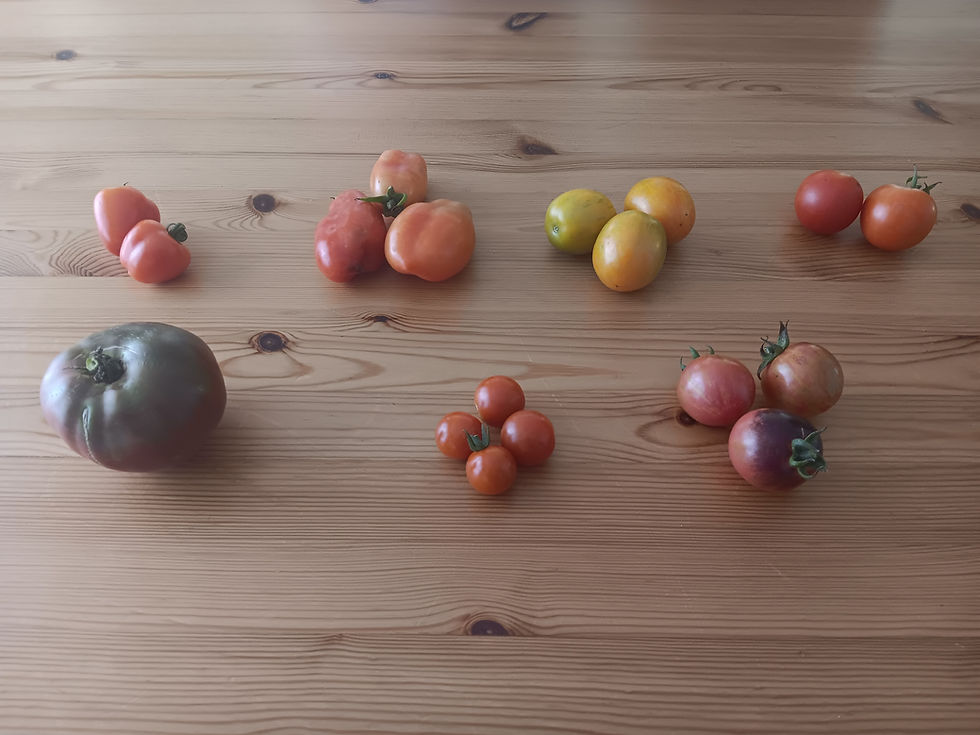Tomato Season - Early Tomatoes
- Ed
- Aug 19
- 3 min read
The tomatoes have slowing been ramping up over the past couple of weeks, and have reached peak. This year, it seemed like it took a while for the ripening to begin. Now, the vines are packed with fruit.

As we begin eating, drying, and preserving tomatoes, we have also been tasting and evaluating. This year, we got carried away and planted eleven varieties, plus several that we got from an Amish neighbor as fruit last year and saved the seeds. We also have a couple of yellow pear cherry tomato plants, which we think Maggie started by harvesting fruit last year and trying a new seed starting method over the winter. So roughly fourteen or so varieties.
The following is a summary on the performance of our seven early varieties:
Black Strawberry - These are large cherry-type tomato that are black and red,. These seeds were from Baker Creek, which has all kinds of weird tomatoes. They started to produce slowly but are ripening fast now. While attractive and a possible good addition to a farmer's market table, we probably won't grow these again.
Apricot Zebra - Another Baker Creek variety, these are small slicers. These did not yield a lot of fruit. so a bit of a dud this year. An interesting color, but we have grown better varieties of yellow tomatoes. We'll probably pass on these also.
San Marzano - A plum style tomato for paste. They have been slow to ripen for us this year, but still a keeper.
Cherokee Purple - These are among the first large tomatoes to ripen. They are gnarled but great slicers, providing plenty of tomato for BLTs that fade in production just as the Beefsteak and other slicers come on. We have grown these for years and will continue to do so.
Sweetheart Cherry - These are odd little tomatoes. Cherry-sized, they are almost more of a paste or plum tomato. They kind of grew on me as the season wore on as they did not split much when overripened, and they were firmer and less juicy than a typical cherry tomato. They did well for us and ripened early, but we will probably not grow these again.
Supersweet Cherry - Classic cherry tomato, forming in bunches. Not sure if it was because of the weather or our laziness in keeping up with picking, but I felt like we lost a lot to cracked fruit. An OK variety, but I would be willing to try a different cherry tomato given the cracking we saw. Sungold has been good in the past, so maybe we will revisit that one.
Chadwick - For some reason, we like these tomatoes. They are large for a cherry tomato, but they ripen early to give us a slightly larger tomato than standard cherry varieties for early sandwiches.
One observation we have made this year is that we are finding large cherry tomatoes such as the Chadwick and Black Strawberry try to be a solution to a problem that doesn't exist - they are too big for use as a cherry tomato and too small for a slicer. I did find it nice to slice and use a whole tomato or two in a sandwich, than to slice a larger tomato and have leftovers, but we do have a refrigerator. While the Black Strawberry seems a little firmer than the Chadwick, I have a hard time getting past the feeling that the Black Strawberry is more of a novelty. Plus, we got more Chadwick's early in the season than we did the Black Strawberry, and more fruit per plant.
Maggie has already canned our quota of tomato sauce for the season, and I made a batch of taco sauce. Maggie has switched to dehydrating the tomatoes. We also continue to eat seasonally from the garden. We just finished a cauliflower, tomato, and pepper stuffed pizza, and are now eating BLTs. Lunches have shifted from salads to slices of bruschetta and tomato soup. Plants are starting to die back, but there is still plenty of growing season left.



Comments